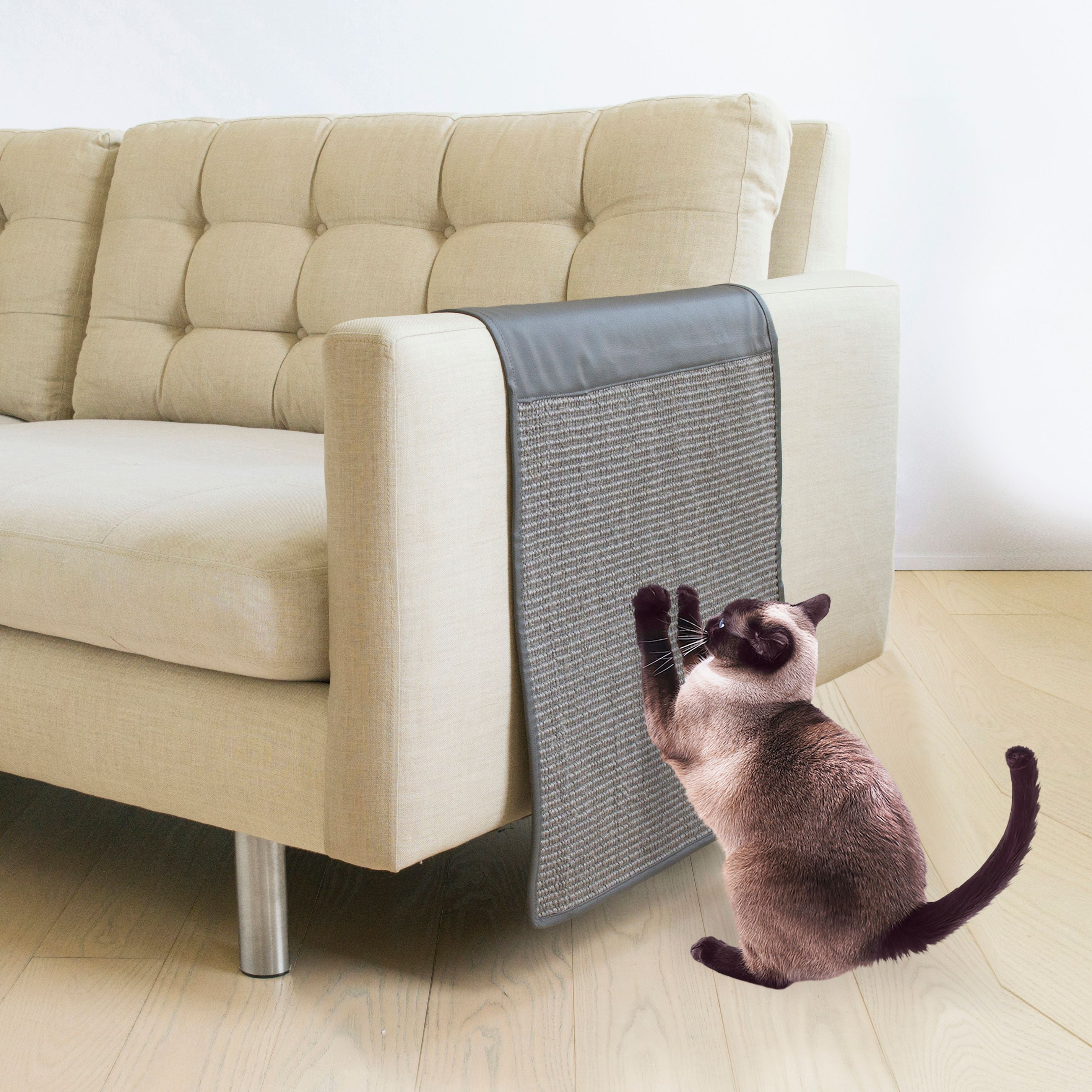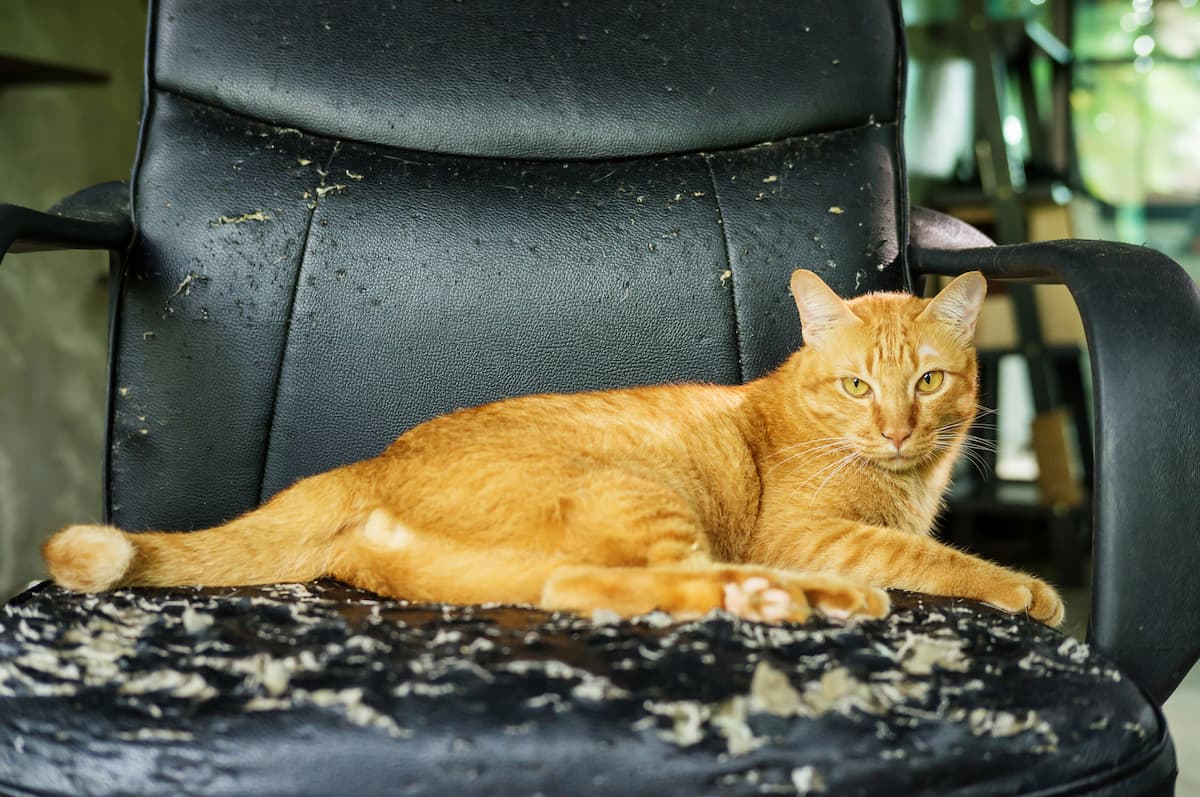Understanding Cat Scratching Behavior

Cats scratching furniture, especially leather chairs, is a common problem for many pet owners. While it can be frustrating, it’s important to understand the reasons behind this behavior to effectively address it. Scratching is a natural instinct for cats, serving several purposes, and understanding these motivations is crucial for finding solutions.
Types of Scratching Behaviors and Their Causes
Scratching behaviors in cats can be categorized into different types, each with its own underlying causes.
- Territory Marking: Cats have scent glands in their paws, and scratching deposits their scent on surfaces, marking their territory. This is particularly common in multi-cat households, where cats may compete for space and resources.
- Stretching and Exercise: Scratching helps cats stretch their muscles and maintain their claws, which are essential for hunting and climbing.
- Stress Relief: Scratching can be a stress-relieving behavior for cats. When cats are anxious or bored, they may scratch more frequently.
Common Misconceptions about Cat Scratching
There are several misconceptions about cat scratching that can hinder effective solutions.
- Cats Scratch to Be Naughty: This is incorrect. Scratching is a natural instinct for cats, and it’s not about being naughty or spiteful.
- Declawing Solves the Problem: Declawing is a painful and mutilating procedure that should be avoided. It removes the cat’s claws, which are essential for their well-being and can lead to behavioral problems.
- Cats Scratch Only Leather Furniture: While leather furniture is often a target, cats will scratch any surface that provides the right texture and resistance.
“Scratching is a natural instinct for cats and is essential for their well-being. Instead of punishing or declawing, it’s important to provide appropriate scratching posts and address the underlying causes of their behavior.”
Effective Deterrents and Solutions

Preventing cats from scratching leather chairs can be a challenge, but with the right strategies, you can protect your furniture while keeping your feline friend happy. Understanding the reasons behind their scratching behavior is crucial to choosing the most effective deterrents and solutions. This section explores various methods categorized by their approach, including physical barriers, repellents, training methods, and environmental enrichment.
Physical Barriers
Physical barriers are a straightforward approach to preventing cats from accessing the leather chair altogether. These barriers create a physical deterrent, making it impossible for cats to reach the furniture.
- Cat-Proof Covers: Covering the chair with a cat-proof cover, such as a thick blanket or a dedicated furniture protector, provides a barrier between your cat’s claws and the leather. These covers are readily available in various materials and styles, allowing you to find a suitable option that blends with your décor. The effectiveness of this method depends on the cover’s material and your cat’s determination. Some cats might find ways to tear through less durable covers, while others might simply avoid the chair altogether due to the unfamiliar texture.
- Furniture Guards: Furniture guards are specifically designed to protect furniture from cat scratches. These guards typically consist of clear plastic or acrylic sheets that attach to the chair’s arms and back, creating a barrier that prevents cats from accessing the leather. While these guards offer a reliable solution, they can be aesthetically unappealing and might affect the chair’s comfort.
- Furniture Scratching Posts: Providing alternative scratching surfaces near the chair can redirect your cat’s scratching behavior. Scratching posts come in various materials, sizes, and designs, catering to different cat preferences. By placing a scratching post strategically close to the leather chair, you encourage your cat to scratch the post instead. However, this method might not be entirely effective, as some cats might prefer the leather chair’s texture.
Repellents, Stop cat scratching leather chair
Repellents work by creating an unpleasant sensory experience for cats, discouraging them from scratching the leather chair. Repellents can be applied directly to the furniture or used in a diffuser form.
- Citrus-Based Repellents: Cats are known to dislike citrus scents. Spraying the leather chair with a diluted citrus-based solution or placing citrus peels near the chair can deter them from scratching. This method is relatively safe and easy to implement, but its effectiveness can vary depending on the cat’s sensitivity to citrus. Some cats might be indifferent to the scent, while others might find it overpowering and unpleasant.
- Commercial Repellents: Several commercially available repellents are specifically designed to deter cats from scratching furniture. These repellents often contain natural ingredients like bitter apple or peppermint oil, creating a bitter taste or an unpleasant smell that discourages scratching. However, the effectiveness of these repellents can vary, and some cats might develop a tolerance to the taste or smell over time.
- Homemade Repellents: You can create homemade repellents using readily available ingredients like vinegar, pepper, or essential oils. These solutions can be sprayed on the leather chair to create a deterrent effect. However, it’s crucial to test these solutions on a small, inconspicuous area of the leather first to ensure they don’t damage the material.
Training Methods
Training methods aim to modify your cat’s behavior by associating scratching the leather chair with negative consequences or positive reinforcement.
- Positive Reinforcement: Positive reinforcement involves rewarding your cat for desired behavior. When you catch your cat scratching an appropriate surface like a scratching post, reward them with treats, praise, or playtime. This positive association encourages them to repeat the desired behavior.
- Negative Reinforcement: Negative reinforcement involves associating scratching the leather chair with an unpleasant experience. You can use a loud noise, a spray bottle filled with water, or a verbal reprimand to discourage scratching. However, it’s crucial to be consistent and avoid punishing your cat for scratching other objects.
- Redirection: Redirection involves diverting your cat’s attention from the leather chair to a more appropriate scratching surface. When you see your cat approaching the chair, immediately redirect them to a scratching post or another designated scratching area.
Environmental Enrichment
Environmental enrichment aims to provide your cat with stimulating activities and resources, reducing their need to scratch the leather chair out of boredom or frustration.
- Interactive Toys: Providing your cat with interactive toys like puzzle feeders, feather wands, or laser pointers can stimulate their hunting instincts and keep them entertained. This can reduce their desire to scratch the leather chair out of boredom.
- Vertical Space: Cats are naturally inclined to climb and explore vertical spaces. Providing them with cat trees, shelves, or perches allows them to satisfy this instinct and reduces their need to scratch the chair for attention.
- Scratching Posts: Ensuring you have an adequate number of scratching posts in different locations and materials can satisfy your cat’s natural urge to scratch.
Maintaining Leather Furniture: Stop Cat Scratching Leather Chair

Leather furniture, with its timeless elegance and durability, can be a cherished addition to any home. However, cats, with their natural instinct to scratch, can pose a significant challenge to maintaining the pristine condition of leather chairs. This section will delve into practical tips and strategies for cleaning, maintaining, and repairing leather furniture to minimize damage caused by feline companions.
Cleaning Leather Furniture
Regular cleaning is crucial for preserving the beauty and longevity of leather furniture. It helps remove dirt, dust, and allergens, preventing the buildup of grime that can attract cats to scratch.
- Vacuum Regularly: Use a soft-bristled brush attachment to gently remove dust and loose debris from the leather surface. This prevents the accumulation of dirt that can attract cats to scratch.
- Wipe Down With a Damp Cloth: Use a soft, slightly damp cloth to wipe down the leather surface. Avoid saturating the leather, as excessive moisture can damage it.
- Use a Leather Cleaner: For deeper cleaning, use a specialized leather cleaner designed for the type of leather on your furniture. Follow the instructions on the cleaner’s label carefully.
- Condition Regularly: Conditioning leather furniture helps maintain its moisture balance, keeping it supple and preventing cracking. Use a high-quality leather conditioner and apply it according to the manufacturer’s instructions.
Repairing Minor Scratches and Scuffs
Minor scratches and scuffs on leather furniture are common, especially with pets around. Fortunately, these blemishes can often be repaired with a few simple techniques.
- Leather Repair Kit: Use a leather repair kit specifically designed for filling in scratches and scuffs. These kits typically contain a color-matching filler and a sealant to protect the repaired area.
- Leather Conditioner: Applying a generous amount of leather conditioner to the scratched area can sometimes help minimize the appearance of minor scratches by hydrating the leather and making it more pliable.
- Professional Restoration: For deeper scratches or tears, consider consulting a professional leather restoration specialist. They have the expertise and tools to repair more significant damage.
Preventing Future Damage
Proactive measures can help prevent future damage to your leather furniture.
- Trim Claws Regularly: Keeping your cat’s claws trimmed is essential. Short claws are less likely to cause deep scratches on leather surfaces.
- Provide Scratching Posts: Offer your cat multiple scratching posts made of sisal rope or cardboard. Place them strategically near areas where your cat likes to scratch, such as near the furniture.
- Cover Furniture: Consider covering your leather furniture with a throw blanket or a slipcover. This provides a barrier between your cat’s claws and the leather surface.
- Use Deterrents: Apply deterrents like citrus spray or commercial cat repellents to areas where your cat tends to scratch. However, ensure these products are safe for both your cat and your furniture.
Stop cat scratching leather chair – The sight of your cat’s sharp claws digging into your beloved leather chair can be utterly heartbreaking. It’s like watching a masterpiece slowly being defaced. If you’re determined to protect your beautiful modern red leather chair from this furry menace, you’ll need to be proactive.
Thankfully, there are a variety of solutions, from cat-friendly scratching posts to deterrents that can help you reclaim your chair and keep your feline friend happy.
The sight of your cat’s sharp claws digging into your beloved leather chair can be heartbreaking. It’s a battle you might feel like you’re losing, but don’t despair! Perhaps a plush, red leather captains chair might be the perfect solution.
Not only will it provide a comfortable spot for you to relax, but it can also serve as a distraction for your feline friend, giving your original chair a much-needed break. With a little patience and some creative solutions, you can keep your furniture safe and your cat happy.
